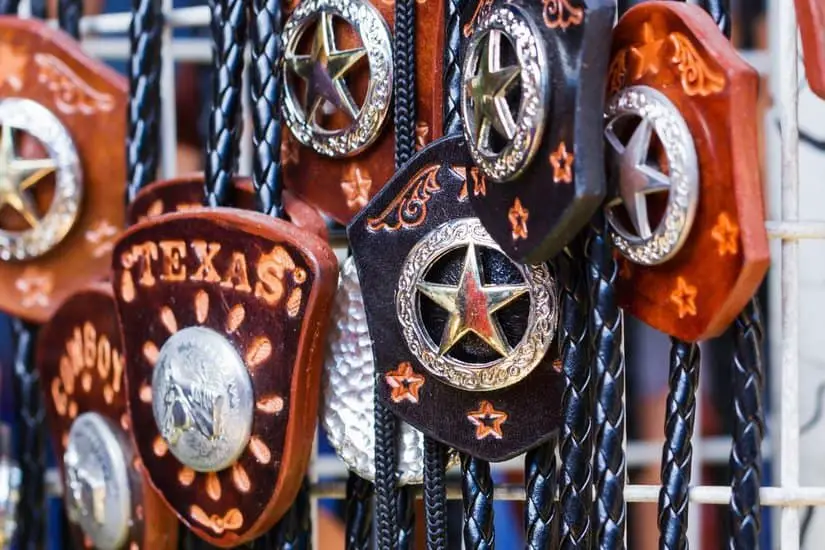The bolo tie is a fairly underrated accessory that many people might not be aware of.
Most people associate the bolo tie with spaghetti westerns and cowboys, but its tradition is perhaps more poignant and purposeful for some cultures than others.
In the western parts of the US the bolo tie is often worn as they can be cheap, and both smart and casual.
A bolo tie can set you apart from those who wear neckties and more traditional ties as an outsider, perhaps paying tradition to their working class roots or perhaps even to their heritage.
In the article we have discussed the history of the bolo tie, what it means to different people, and ultimately how to style it.
Bolo Ties Go By Different Names
Bolo ties go by different names, mostly depending on geographical regions. The three other common names for bolo ties include bola tie, string tie (based on design), and cowboy tie (based on spaghetti westerns).
Bolo ties’ designs and styles also vary slightly. The constant in a bolo tie’s design is the leather cord. The cord is threaded through a clasp or slide, a notable difference.
The clasp or slide can come in three different materials: beads, wood, or metal – other materials are usually rare and custom-made. The clasp or slide can also be decorated in different styles, most commonly western designs such as cattle skulls, bears, and horses.
The History Of The Bolo Tie

What many people don’t recognize is that the bolo tie is a big part of the Westernization of the Native Americans.
Since the mid-twentieth century, Native Americans have been pushed to assimilate into US culture, part of which is adopting their fashion.
Many Native American men chose to wear the bolo tie to, at the very least, set them apart from western traditions of suit wear and tie wear, and at the most to pay homage to a tradition of amulets and trinkets in their own culture.
A citizen of Arizona, where the tie is now considered to be the official neckwear of the state, claims to have created the bolo tie in the 1940s and patented the sliding design in 1954.
On old cowboy hat designs there was an accessory known as the ‘hat band’. This is a circlet that surrounds the external crown of the hat.
They are often used to keep feathers in and other things but are mainly for aesthetics.
Victor Cedarstaff, the citizen in question, claimed his hat kept blowing off while riding his horse. Wary of losing the precious and valuable hat band he had, he put it around his neck.
After receiving compliments on his new and different tie, he seems to have started a trend.
Whether Victor did in fact create the bolo tie or not isn’t worth the debate. But, what this story does show is that the bolo tie is highly related to cowboy culture.
Cowboys are often on the road and live a nomadic life weather they won’t carry much around with them.
In a situation such as a wedding or funeral, a cowboy may need to look smart quickly, and the likelihood of them keeping a necktie in their knapsack is unlikely.
Many people think the bolo tie came from cowboys tying their hat band around their shirt collar like a tie, and it was styled from then on.
Where to Get Bolo Ties
Bolo ties are surprisingly easy to find. You can order one online through platforms such as Amazon and eBay. However, be vigilant when shopping online as some bolo ties are generic and cheap designs, remnants of the 1980s bolo tie craze. You can also find vintage styles at local thrift stores.
You can also find good bolo ties at local western clothing stores. However, you should consider visiting the American Southwest if you are looking for a classic or exquisite piece. You can even find a craftsman to make you a customized bolo tie.
Why Wear A Bolo Tie Over A Necktie?
Beyond a bolo tie simply being a little different to a necktie, a bolo tie can represent a completely different style and fashion to your regular necktie.
While neckties themselves can be pretty different and unique, a bolo tie can really set you apart from other people at an event.
A bolo tie can show that you are a little more rugged, almost like a cowboy, and that you are an outsider.
Bolo ties, historically, as we outlined, represent the cowboys who have come from out of town who don’t have time for ties, so generally give off this more casual vibe but still shows you recognize the formality of a situation.
In a practical sense, many people find the cloth necktie to be quite uncomfortable and tight. A bolo tie can be much looser and doesn’t have so much tension in it which many people enjoy.
A bolo tie can also represent heritage. Many Native American men, even in the modern world, wear the bolo tie out of respect for their culture of trinkets.
The actual tie itself may be its own trinket or emblem for a family or area.
Additionally, a lot of people wear bolo ties in the south. If you are attending an event in North America, a bolo tie can show you are representing the southern states and where you came from.
How To Wear A Bolo Tie

The best thing about a bolo tie is that you can style it up for a wedding or funeral or similar event, or you can style it down for something casual that you could even wear to a bar.
It’s all about where you are going and what you are wearing, as it always is with fashion.
1. Style It Down
The best thing about a bolo tie is that you can wear them fairly casually, your main requirement is a collared shirt.
Obviously, western or ‘cowboy’ shirts, the ones that often have embroidery on the front shoulder or chest portions, are made for the bolo tie and are a great opportunity to dress them down.
With any style of western shirt you can undo your top button and loosen your bolo tie.
This is a really cool look for a square dance and in a non-western environment will stand out strongly.
If you really want to lament this style then also consider getting some collar tips for your shirt.
If the tips on your bolo tie and the tips on your shirt match or are the same color you are scoring aesthetic points across the board.
If you are going to style it down like this, a pair of denim can look real good with these kinds of western shirts and bolo ties.
Add a pair of leather cowboy boots to that outfit and you will look stylish, refined, but still a little rugged, as well as unique.
We have even seen some folk wear bolo ties with a t- shirt. We will leave this debate up to you, but it sort of defeats the point of dressing down and up at the same time.
2. Dress It Up
Wearing a bolo tie and a western shirt with some cowboy boots to the local dive bar is a cool move and will make you stand out.
But we like to think that most people can pull off that look. Just look around Arizona and you will see that look everywhere.
Wearing a bolo tie with a formal suit can be relatively hard to pull off. The main issue here being the gaping space the bolo tie leaves past your breastbone.
For instance, a black suit and white shirt with a bolo tie can look a little weird because of the large white space.
One way to beat this is to wear a fancy belt buckle. The belt buckle and the bolo tie go hand in hand and are from the same eras and region in reality.
The belt buckle can take the eyes away from the empty space the bolo tie creates.
As the bolo tie became pretty popular in the 80s this sort of created a perfect storm.
The larger than fit suits that people often wore in the 80s was the perfect combination with the bolo tie.
The larger suit again helps distract from the empty white space that can look out of place.
If you want to see someone wearing a bolo tie with a formal suit, and doing it well, just look at Bruce Springsteen’s 1987 album ‘Tunnel of Love’ – he rocks a bolo tie on the cover and looks great.
3. Dress Somewhere In The Middle

As the bolo tie can be both casual and formal, somewhere in the middle can be a winning combination.
Combining smart and casual fashion has never been easier than with a bolo tie. On a naked shirt the bolo tie could potentially look out of place if worn incorrectly.
The blazer, or suit jacket, is a great accompaniment to the bolo tie.
A great look is to combine jeans, cowboy boots, a good western shirt, your bolo tie of choice, and a suit jacket with pocket square.
This is perhaps the bolo tie’s perfect home, it is respectable, rugged, and stylish – everything a southern man should be.
Colin Farrell’s character in Season 2 of the show True Detective rocks this look to a tee.
The costume designer on this show hit the ‘southern cop’ look on the head as Farrell epitomizes the off duty, rough, southern detective look you can see across any southern US state.
Final Thoughts
There you have it, the bolo tie.
When we see someone with a bolo tie, it is a fashion statement of the southern man who wants to wear his southern pride around his neck.
For the same reasons, many Native Americans and Mexicans see the bolo tie as a sign of their culture.
Harking back to the days of cowboys, the bolo tie has been the epitome of smart-casual dress and was originally a way for the cowboys of the world to attend formal events.
With the right style and outfit, a bolo tie can be really unique and stylish and show you are thinking outside the box of what other people will expect you to wear.
The bolo tie is the neck accessory of the outsider who doesn’t conform to your rules.
FAQs
What is the origin of the bolo tie?
Bolo ties are inspired by Indian culture. They date back to the 1930s when Manny Goodman got the idea from the bandanas that local Indian tribes wore around their necks.
Does a bolo tie symbolize anything?
Most people associate their bolo ties with significant achievements or developments. For example, you can get one to symbolize your graduation or engagement.
How far down should you wear a bolo tie?
It is recommendable to wear your bolo tie about three or four inches from the base of your breastbone. However, depending on your general look, you can also style it up or dress it down.
Can you wear a bolo tie with a t-shirt?
You can wear a bolo tie with a t-shirt and other casual clothing. However, ensure you do the bolo tie justice by going for a stylish look.

Samoel Ovanessian is the founder and creator of StylishAlpha.com – a website dedicated to men’s fashion. As a proud owner of more than 200 ties, he loves digging through new clothing combinations for everyday use, formal events and even just for fun. You can read more about Samoel here.

